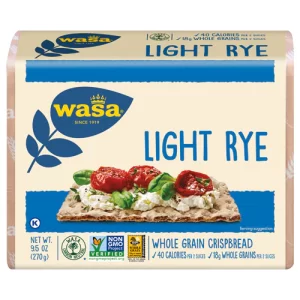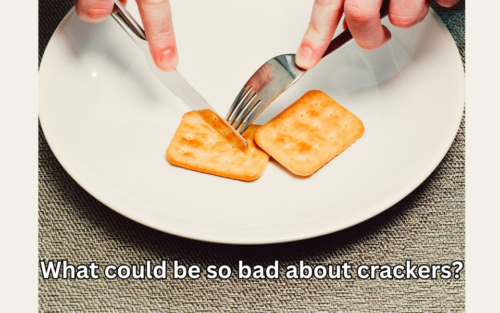I got some panicked responses after a newsletter that included crackers on the list of processed foods that aren’t such good friends on the health journey. As one reader emailed: “Crackers are bad? Say it ain’t so Mary! I’m such a cracker scooper!”
Indeed, what could be wrong with crackers? They’re not filled with sugar like cakes and cookies, they aren’t salty and greasy like French fries and there are lots of helpful health claims on their packaging. As another reader wondered, is the problem that “they’re just carbs and fat”
These kinds of questions called for some expert advice. Fortunately, integrative and functional nutritionist Karen Kennedy is joining me to help sort through these cracker questions. Following is our conversation.
Nutrition in a Box?
Mary: There’s a lot of talk these days about the health dangers of processed foods. Karen, you’ve created a video on how to choose healthier crackers which included this great line: “The solution to our nutrition questions are rarely found in a box.” Why is that? What’s so bad about food in boxes?
Karen: To be clear, not every packaged food is nutritionally deficient. But a high percentage of packaged foods are what we call “ultra-processed foods.” A recent article defined “UPFs” as basically just “industrial formulations,” rather than actual foods. In other words, they are:
“made entirely of substances extracted from other foods or synthesized in laboratories. They’re made through industrial techniques like extrusion, molding, pre-processing, and frying. And they contain all sorts of additives that make them hyper-palatable. That means they’re designed to achieve a certain bliss point that makes us in many ways crave and essentially overeat them.”
“How to spot (and avoid) ultra-processed foods,” Washington Post, January 19, 2024
The Secret Key
Mary: So how can you tell if a packaged food is health-supporting or a health-detracting UPF?
Karen: That’s easy: Read the Ingredient Listing. I know that can be aggravating because who wants to pore through and decipher all that tiny fine print? But that’s the point! If that fine print is hard to decipher, then you’ve likely got an ultra-processed food. Put it back and look for a “clean” substitute with ingredients that are easy to read, understand and are actual foods from the ground.
Here is an example of an aggravating and problematic ingredient listing: vs. a simple, real whole food listing:
Typical Club Cracker: Enriched flour (wheat flour, niacin, reduced iron, vitamin b₁ [thiamin mononitrate], vitamin b₂ [riboflavin], folic acid), vegetable oil (soybean, palm and palm kernel oil with tbhq for freshness), whey, sugar, cheddar cheese (milk, cheese cultures, salt, enzymes), contains 2% or less of salt, leavening (baking soda, sodium acid pyrophosphate, monocalcium phosphate), natural and artificial flavor, sodium phosphate, butter (cream, salt), citric acid, nonfat milk, turmeric extract color, yellow 6, peanut flour, soy lecithin
Triscuits Original: Whole grain wheat, canola oil, sea salt.
The Packaging Trap
Mary: I’m guessing we might sometimes skip the aggravation of an ingredient listing because a product’s packaging says it’s “Healthy,” or “Low Fat,” or something else that makes it seem nutritionally safe. Is that a sensible approach? One of our readers shared a good piece of advice: “The more claims are on a package, the more likely you want to give it a pass!”
Karen: Absolutely true! Most packaging claims are pretty meaningless because they have no defined meaning. And by the way, don’t get misled by packaging with natural-looking colors, designs and even environmental claims! The ingredient listing is the only way to determine if a product is an UPF.
The Common Ingredient Trap
Mary: It seems easy enough to weed out products with a lot of gobbledygook entries in their ingredient listings, like yellow 6 and artificial flavor, but it can be harder when it comes to common things like flour, sugar and oil, i.e., the main ingredients in most crackers. They don’t seem so bad.
Karen: While those kinds of familiar ingredients do seem pretty harmless, they are still refined and processed.
- FLOUR For instance, “flour” or “wheat flour,” as it’s often listed, is code for white flour made by grinding away the most nutritious parts of the wheat kernel (the bran and germ), leaving the starchy white inside (the endosperm) that has little to recommend it nutritionally.

Manufacturers like making products with the white starchy innards because they are very shelf-stable, meaning they can last a long time on store shelves, even though they are nutritionally deficient for consumers.
To avoid common processed white grains, look for grain ingredients accompanied by the word “whole” in the ingredient listing, e.g. “whole wheat,” or for rice, “brown rice.”
- SUGAR It’s easy to understand why common sugar is an ultra-processed food by simply considering what processing must transpire to transform rough and tough sugar cane or sugar beets into pretty white granules of sugar. However, trying to gauge their prevalence in a packaged food is tricky.
Manufacturers are required to list ingredients in descending order based on their weight. To skirt the potentially negative appearances required by this rule, manufacturers often add sugar in different forms, e.g. cane sugar, corn syrup, evaporated cane juice, barley malt, dextrose, sucrose and more. By splitting them up, the various sugar additions can be hidden throughout the ingredient listing rather than being listed as the first or second ingredient, raising a clear red flag for consumers.
- OILS Very often the better oils, like olive and avocado, are too expensive for low-cost crackers, so low-cost and nutritionally inferior oils are used instead, many extracted through less healthy processes.
But Are Crackers Really Not-So-Good?
Mary: OK, so maybe crackers are made with white, refined flours and not-so-great oils. Why is that so bad? I know you specialize in blood sugar and digestive health. Is that where some of the problems lie?
Karen: Yes, coming strictly from the perspective of metabolic health, most crackers simply jack up your blood sugar while offering nothing in the way of nutrition. They don’t even fill you up and actually tend to leave you wanting more. They promote snacking instead of nutritious eating. And they give you nothing in terms of valuable nutrition in return.
That said, if you use just a few crackers as a vehicle for something more nutritious, where you just want a bit of added crunch (see below for ideas), and it doesn’t cause problems for your blood sugar, then that’s fine.
The Shut-Outs
Mary: In addition to the direct health consequences you mentioned, Karen, it seems another problem with crackers–and most ultra-processed foods–is what they displace in the diet.
In other words, most of these processed foods feature refined grains, sugars, salt and fat in combinations designed specifically so “you can’t eat just one” or even just a few. While this is good for manufacturers’ sales figures, it almost forces us to overeat nutritionally empty calories.
This can then leave little appetite for the nutritionally dense foods our bodies so desperately need, i.e., all those nutrient-rich foods the experts are always telling us to eat, like nuts, seeds, clean proteins, legumes, good fats, fruits and vegetables!
Karen: And over time, it becomes harder and harder to focus on these real, whole foods because our taste buds get hi-jacked by highly refined, artificially flavored UPFs.
Substitute Solutions
Mary: “But I just want a cracker.” You mentioned that this is something you often hear from your clients. So is there anything you can recommend for those with a cracker craving?
Karen: Start by swapping. Fortunately, manufacturers are responding to consumer demand for healthier products and so there are now a number of crackers made with whole grains and without sugar.
Most will still include not-so-great oils and too much salt, so see if you can find better substitutes on those counts as well.
WASA Light Rye Crisps are my go-to cracker as they contain only whole grain rye flour and salt. Other good choices from a blood sugar perspective include Flackers, Top Seedz, Cult Crackers, and Brad’s Veggie Flats.
Mary: I remember the rye crisps of years past and they were hearty for sure! You could barely chew through one! But the “Light” rye packaging says the crackers are made with a mild whole grain rye flour, have a delicate taste and are light and crispy. Do you find that to be true?
Karen: Yes, but even so, you still aren’t tempted to eat more than a couple, leaving plenty of runway for all the other foods we need to be eating, especially VEGETABLES! Mary do you have a favorite cracker?
Mary: Because I have a gluten intolerance, I like Edward & Sons Brown Rice Snaps, made with just Whole Grain Brown Rice, Tamari and Sesame Seeds. And while they are good, they aren’t so good that I could eat a whole boxful!
Recipes
Mary: I like your idea of starting with a cracker like Rye Crisps without poor added fats but then adding your own good fats.
Karen: Topping them with avocado slices, liver pate, hummus and sprouts are some of my favorites–which makes them both more filling and nutritious.
Mary: I do a similar thing, especially when I’m out hiking and need a mobile lunch. I top Brown Rice Snaps with grainy mustard, a little tuna (the jarred variety is really good) and some dried tomatoes with maybe olives on the side.
